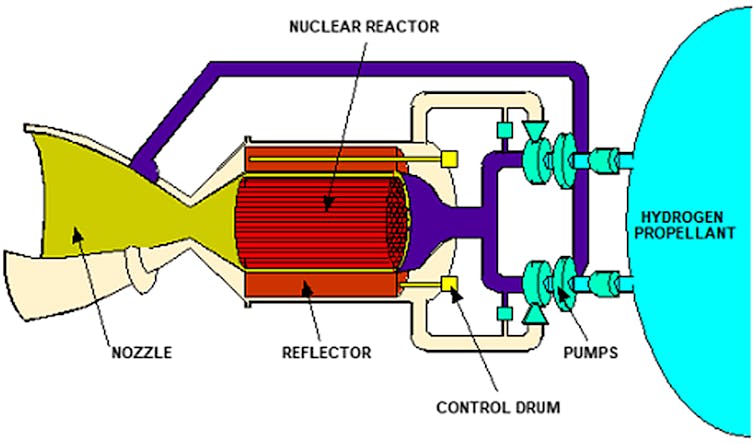NASA plans to send crewed missions to Mars over the following decade—however the 140 million-mile (225 million-kilometer) journey to the crimson planet could take several months to years round trip.
This comparatively lengthy transit time is a results of the usage of conventional chemical rocket gasoline. An alternate expertise to the chemically propelled rockets the company develops now known as nuclear thermal propulsion, which makes use of nuclear fission and will one day power a rocket that makes the journey in simply half the time.
Nuclear fission entails harvesting the unbelievable quantity of vitality launched when an atom is break up by a neutron. This reaction is known as a fission reaction. Fission expertise is nicely established in energy technology and nuclear-powered submarines, and its utility to drive or energy a rocket might someday give NASA a quicker, extra highly effective various to chemically pushed rockets.
NASA and the Protection Superior Analysis Initiatives Company are jointly developing NTP technology. They plan to deploy and demonstrate the capabilities of a prototype system in area in 2027—probably making it one of many first of its variety to be constructed and operated by the US.
Nuclear thermal propulsion might additionally someday energy maneuverable space platforms that may defend American satellites in and past Earth’s orbit. However the expertise remains to be in growth.
I’m an associate professor of nuclear engineering at the Georgia Institute of Technology whose research group builds fashions and simulations to enhance and optimize designs for nuclear thermal propulsion programs. My hope and fervour is to assist design the nuclear thermal propulsion engine that can take a crewed mission to Mars.
Nuclear Versus Chemical Propulsion
Standard chemical propulsion programs use a chemical response involving a light-weight propellant, resembling hydrogen, and an oxidizer. When blended collectively, these two ignite, which leads to propellant exiting the nozzle in a short time to propel the rocket.

These programs don’t require any form of ignition system, so that they’re dependable. However these rockets should carry oxygen with them into area, which may weigh them down. In contrast to chemical propulsion programs, nuclear thermal propulsion programs depend on nuclear fission reactions to warmth the propellant that’s then expelled from the nozzle to create the driving drive or thrust.
In lots of fission reactions, researchers ship a neutron towards a lighter isotope of uranium, uranium-235. The uranium absorbs the neutron, creating uranium-236. The uranium-236 then splits into two fragments—the fission merchandise—and the response emits some assorted particles.
Greater than 400 nuclear energy reactors in operation around the world at the moment use nuclear fission expertise. Nearly all of the nuclear energy reactors in operation are light-water reactors. These fission reactors use water to decelerate the neutrons and soak up and switch warmth. The water can create steam instantly within the core or in a steam generator, which drives a turbine to provide electrical energy.
Nuclear thermal propulsion systems function in an analogous means, however they use a special nuclear gasoline that has extra uranium-235. Additionally they function at a a lot greater temperature, which makes them extraordinarily highly effective and compact. Nuclear thermal propulsion programs have about 10 instances extra energy density than a standard light-water reactor.
Nuclear propulsion might have a leg up on chemical propulsion for a few reasons.
Nuclear propulsion would expel propellant from the engine’s nozzle in a short time, producing high thrust. This excessive thrust permits the rocket to speed up quicker.
These programs even have a excessive particular impulse. Specific impulse measures how effectively the propellant is used to generate thrust. Nuclear thermal propulsion programs have roughly twice the particular impulse of chemical rockets, which suggests they might minimize the journey time by an element of two.
Nuclear Thermal Propulsion Historical past
For many years, the US authorities has funded the event of nuclear thermal propulsion expertise. Between 1955 and 1973, applications at NASA, General Electric, and Argonne National Laboratories produced and ground-tested 20 nuclear thermal propulsion engines.
However these pre-1973 designs relied on extremely enriched uranium gasoline. This gasoline is now not used due to its proliferation dangers, or risks that must do with the unfold of nuclear materials and expertise.
The Global Threat Reduction Initiative, launched by the Division of Vitality and National Nuclear Security Administration, goals to transform most of the analysis reactors using extremely enriched uranium gasoline to high-assay, low-enriched uranium, or HALEU, gasoline.
Excessive-assay, low- enriched uranium gasoline has much less materials able to present process a fission response in contrast with extremely enriched uranium gasoline. So, the rockets must have extra HALEU gasoline loaded on, which makes the engine heavier. To resolve this concern, researchers are wanting into particular supplies that may use gasoline extra effectively in these reactors.
NASA and the DARPA’s Demonstration Rocket for Agile Cislunar Operations, or DRACO, program intends to make use of this high-assay, low-enriched uranium gasoline in its nuclear thermal propulsion engine. This system plans to launch its rocket in 2027.
As a part of the DRACO program, the aerospace firm Lockheed Martin has partnered with BWX Applied sciences to develop the reactor and fuel designs.
The nuclear thermal propulsion engines in growth by these teams might want to adjust to particular efficiency and security requirements. They’ll must have a core that may function throughout the mission and carry out the required maneuvers for a quick journey to Mars.
Ideally, the engine ought to be capable to produce excessive particular impulse whereas additionally satisfying the excessive thrust and low engine mass necessities.
Ongoing Analysis
Earlier than engineers can design an engine that satisfies all these requirements, they should begin with fashions and simulations. These fashions assist researchers, resembling these in my group, perceive how the engine would deal with beginning up and shutting down. These are operations that require fast, huge temperature and strain adjustments.
The nuclear thermal propulsion engine will differ from all present fission energy programs, so engineers might want to construct software program instruments that work with this new engine.
My group designs and analyzes nuclear thermal propulsion reactors utilizing fashions. We mannequin these complicated reactor programs to see how issues resembling temperature adjustments might have an effect on the reactor and the rocket’s security. However simulating these results can take a variety of costly computing energy.
We’ve been working to develop new computational tools that mannequin how these reactors act whereas they’re starting up and operated with out utilizing as a lot computing energy.
My colleagues and I hope this analysis can someday assist develop fashions that would autonomously management the rocket.
This text is republished from The Conversation below a Inventive Commons license. Learn the original article.
Picture Credit score: NASA
Source link
#Nuclear #Rockets #Mars #Time #NASA #Plans #Fly
Unlock the potential of cutting-edge AI options with our complete choices. As a number one supplier within the AI panorama, we harness the ability of synthetic intelligence to revolutionize industries. From machine studying and information analytics to pure language processing and pc imaginative and prescient, our AI options are designed to reinforce effectivity and drive innovation. Discover the limitless prospects of AI-driven insights and automation that propel what you are promoting ahead. With a dedication to staying on the forefront of the quickly evolving AI market, we ship tailor-made options that meet your particular wants. Be part of us on the forefront of technological development, and let AI redefine the way in which you use and reach a aggressive panorama. Embrace the longer term with AI excellence, the place prospects are limitless, and competitors is surpassed.










